Investment Decision
VerifiedAdded on 2023/04/22
|7
|1520
|94
AI Summary
The article discusses investment options for Mr. Edward, a moderate investor, who has SGD 1.5 million to invest. The article compares two proposals, one from Ms. Ang and the other from Ms. Beh. The article suggests diversification of investment to spread the risk. The article also highlights the potential risks and rewards of investing in high-risk investments.
Contribute Materials
Your contribution can guide someone’s learning journey. Share your
documents today.
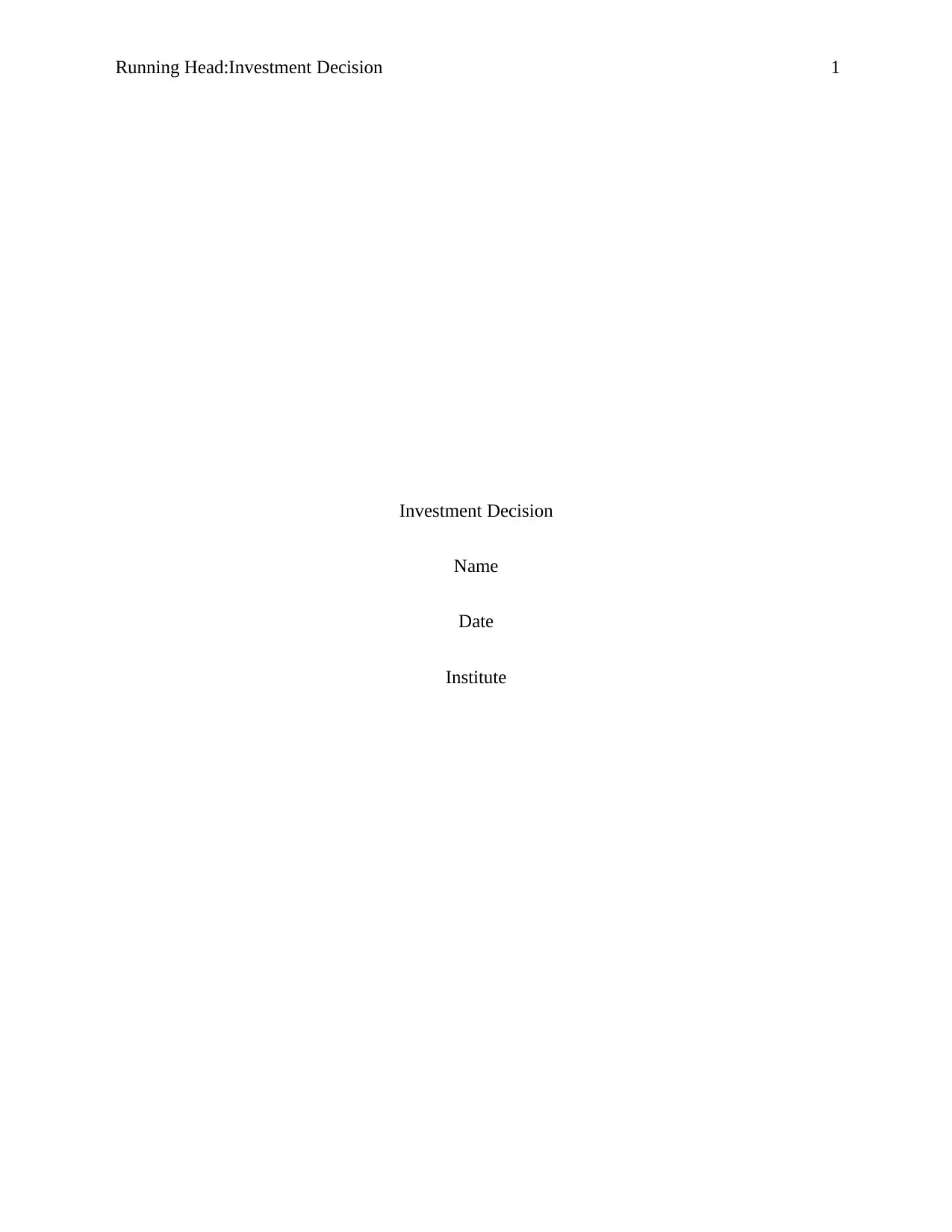
Running Head:Investment Decision 1
Investment Decision
Name
Date
Institute
Investment Decision
Name
Date
Institute
Secure Best Marks with AI Grader
Need help grading? Try our AI Grader for instant feedback on your assignments.
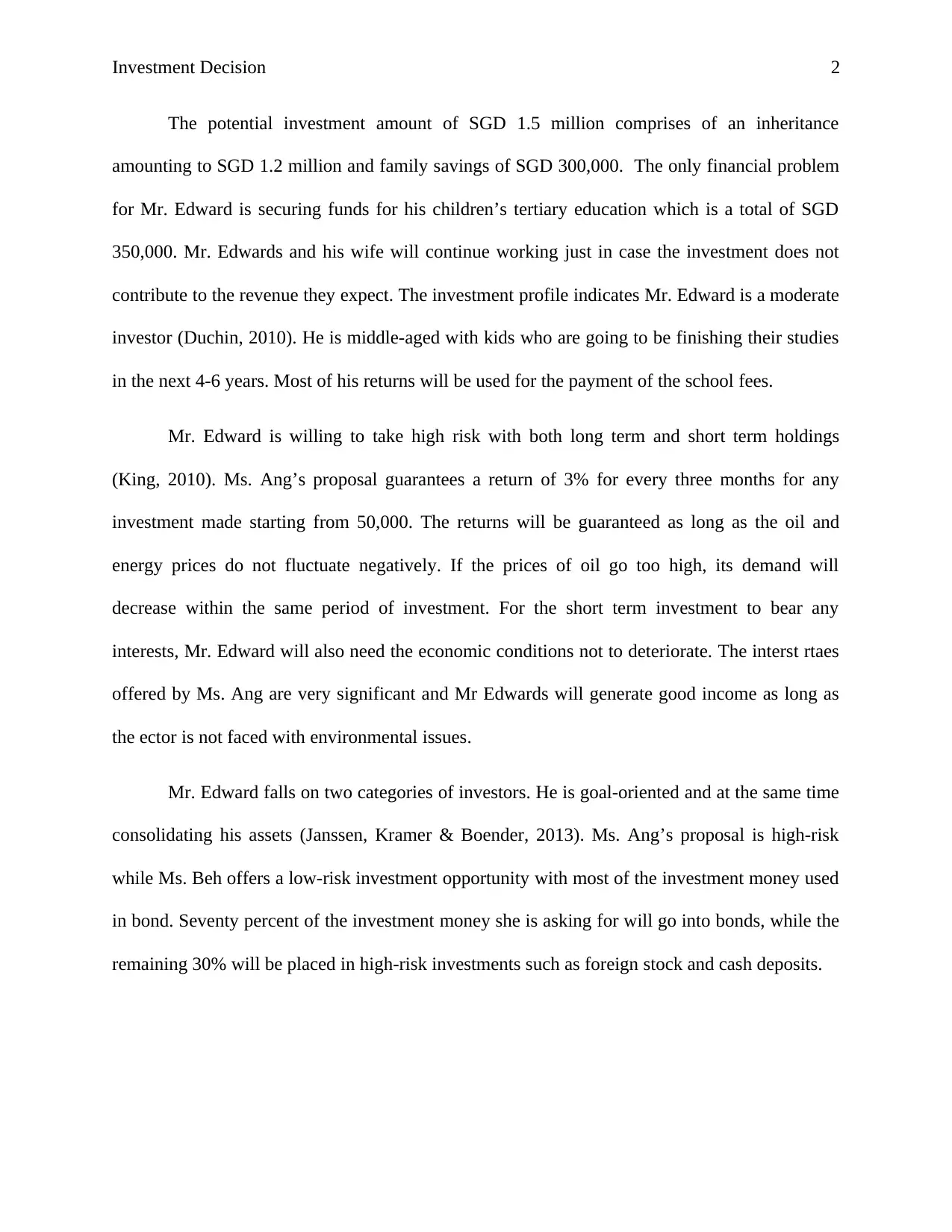
Investment Decision 2
The potential investment amount of SGD 1.5 million comprises of an inheritance
amounting to SGD 1.2 million and family savings of SGD 300,000. The only financial problem
for Mr. Edward is securing funds for his children’s tertiary education which is a total of SGD
350,000. Mr. Edwards and his wife will continue working just in case the investment does not
contribute to the revenue they expect. The investment profile indicates Mr. Edward is a moderate
investor (Duchin, 2010). He is middle-aged with kids who are going to be finishing their studies
in the next 4-6 years. Most of his returns will be used for the payment of the school fees.
Mr. Edward is willing to take high risk with both long term and short term holdings
(King, 2010). Ms. Ang’s proposal guarantees a return of 3% for every three months for any
investment made starting from 50,000. The returns will be guaranteed as long as the oil and
energy prices do not fluctuate negatively. If the prices of oil go too high, its demand will
decrease within the same period of investment. For the short term investment to bear any
interests, Mr. Edward will also need the economic conditions not to deteriorate. The interst rtaes
offered by Ms. Ang are very significant and Mr Edwards will generate good income as long as
the ector is not faced with environmental issues.
Mr. Edward falls on two categories of investors. He is goal-oriented and at the same time
consolidating his assets (Janssen, Kramer & Boender, 2013). Ms. Ang’s proposal is high-risk
while Ms. Beh offers a low-risk investment opportunity with most of the investment money used
in bond. Seventy percent of the investment money she is asking for will go into bonds, while the
remaining 30% will be placed in high-risk investments such as foreign stock and cash deposits.
The potential investment amount of SGD 1.5 million comprises of an inheritance
amounting to SGD 1.2 million and family savings of SGD 300,000. The only financial problem
for Mr. Edward is securing funds for his children’s tertiary education which is a total of SGD
350,000. Mr. Edwards and his wife will continue working just in case the investment does not
contribute to the revenue they expect. The investment profile indicates Mr. Edward is a moderate
investor (Duchin, 2010). He is middle-aged with kids who are going to be finishing their studies
in the next 4-6 years. Most of his returns will be used for the payment of the school fees.
Mr. Edward is willing to take high risk with both long term and short term holdings
(King, 2010). Ms. Ang’s proposal guarantees a return of 3% for every three months for any
investment made starting from 50,000. The returns will be guaranteed as long as the oil and
energy prices do not fluctuate negatively. If the prices of oil go too high, its demand will
decrease within the same period of investment. For the short term investment to bear any
interests, Mr. Edward will also need the economic conditions not to deteriorate. The interst rtaes
offered by Ms. Ang are very significant and Mr Edwards will generate good income as long as
the ector is not faced with environmental issues.
Mr. Edward falls on two categories of investors. He is goal-oriented and at the same time
consolidating his assets (Janssen, Kramer & Boender, 2013). Ms. Ang’s proposal is high-risk
while Ms. Beh offers a low-risk investment opportunity with most of the investment money used
in bond. Seventy percent of the investment money she is asking for will go into bonds, while the
remaining 30% will be placed in high-risk investments such as foreign stock and cash deposits.
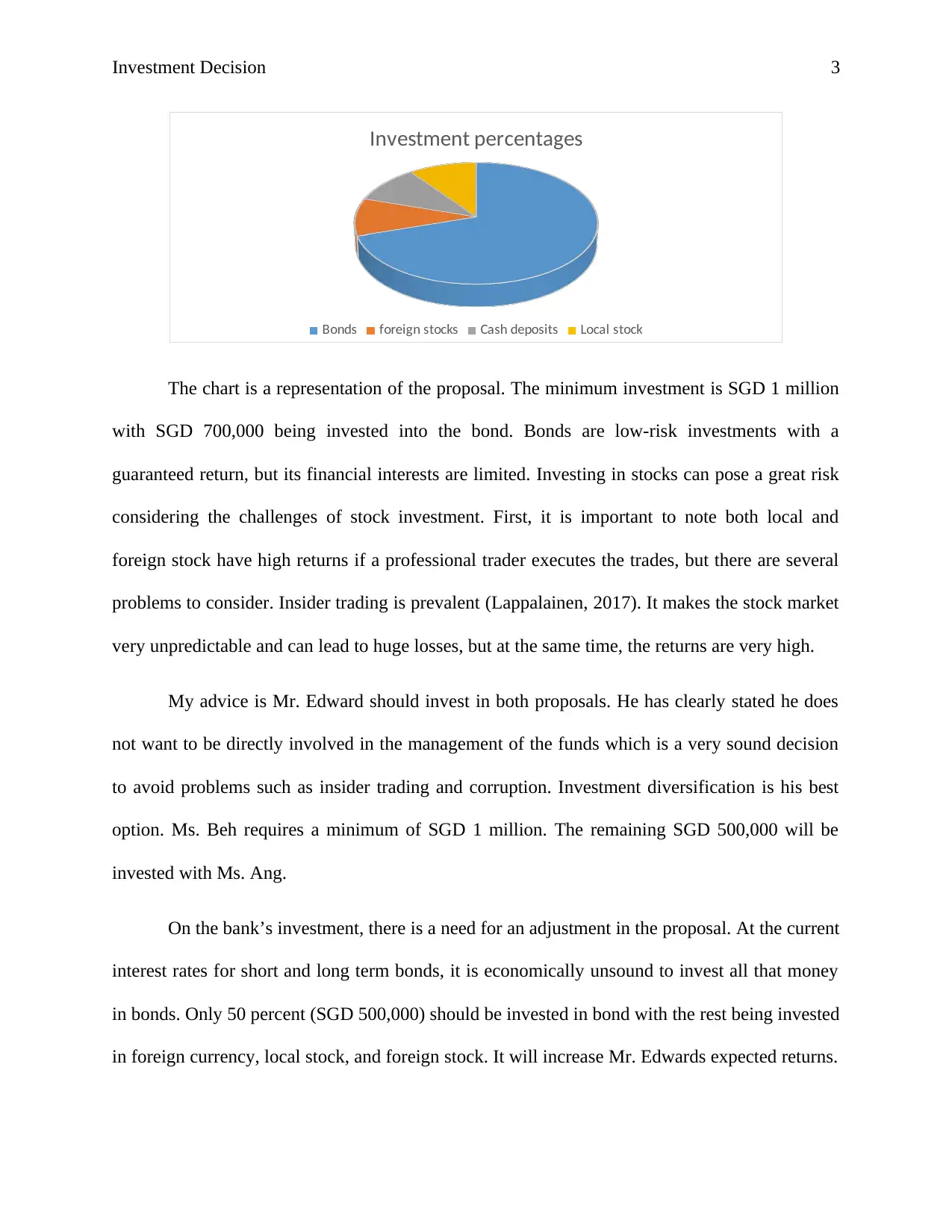
Investment Decision 3
Investment percentages
Bonds foreign stocks Cash deposits Local stock
The chart is a representation of the proposal. The minimum investment is SGD 1 million
with SGD 700,000 being invested into the bond. Bonds are low-risk investments with a
guaranteed return, but its financial interests are limited. Investing in stocks can pose a great risk
considering the challenges of stock investment. First, it is important to note both local and
foreign stock have high returns if a professional trader executes the trades, but there are several
problems to consider. Insider trading is prevalent (Lappalainen, 2017). It makes the stock market
very unpredictable and can lead to huge losses, but at the same time, the returns are very high.
My advice is Mr. Edward should invest in both proposals. He has clearly stated he does
not want to be directly involved in the management of the funds which is a very sound decision
to avoid problems such as insider trading and corruption. Investment diversification is his best
option. Ms. Beh requires a minimum of SGD 1 million. The remaining SGD 500,000 will be
invested with Ms. Ang.
On the bank’s investment, there is a need for an adjustment in the proposal. At the current
interest rates for short and long term bonds, it is economically unsound to invest all that money
in bonds. Only 50 percent (SGD 500,000) should be invested in bond with the rest being invested
in foreign currency, local stock, and foreign stock. It will increase Mr. Edwards expected returns.
Investment percentages
Bonds foreign stocks Cash deposits Local stock
The chart is a representation of the proposal. The minimum investment is SGD 1 million
with SGD 700,000 being invested into the bond. Bonds are low-risk investments with a
guaranteed return, but its financial interests are limited. Investing in stocks can pose a great risk
considering the challenges of stock investment. First, it is important to note both local and
foreign stock have high returns if a professional trader executes the trades, but there are several
problems to consider. Insider trading is prevalent (Lappalainen, 2017). It makes the stock market
very unpredictable and can lead to huge losses, but at the same time, the returns are very high.
My advice is Mr. Edward should invest in both proposals. He has clearly stated he does
not want to be directly involved in the management of the funds which is a very sound decision
to avoid problems such as insider trading and corruption. Investment diversification is his best
option. Ms. Beh requires a minimum of SGD 1 million. The remaining SGD 500,000 will be
invested with Ms. Ang.
On the bank’s investment, there is a need for an adjustment in the proposal. At the current
interest rates for short and long term bonds, it is economically unsound to invest all that money
in bonds. Only 50 percent (SGD 500,000) should be invested in bond with the rest being invested
in foreign currency, local stock, and foreign stock. It will increase Mr. Edwards expected returns.
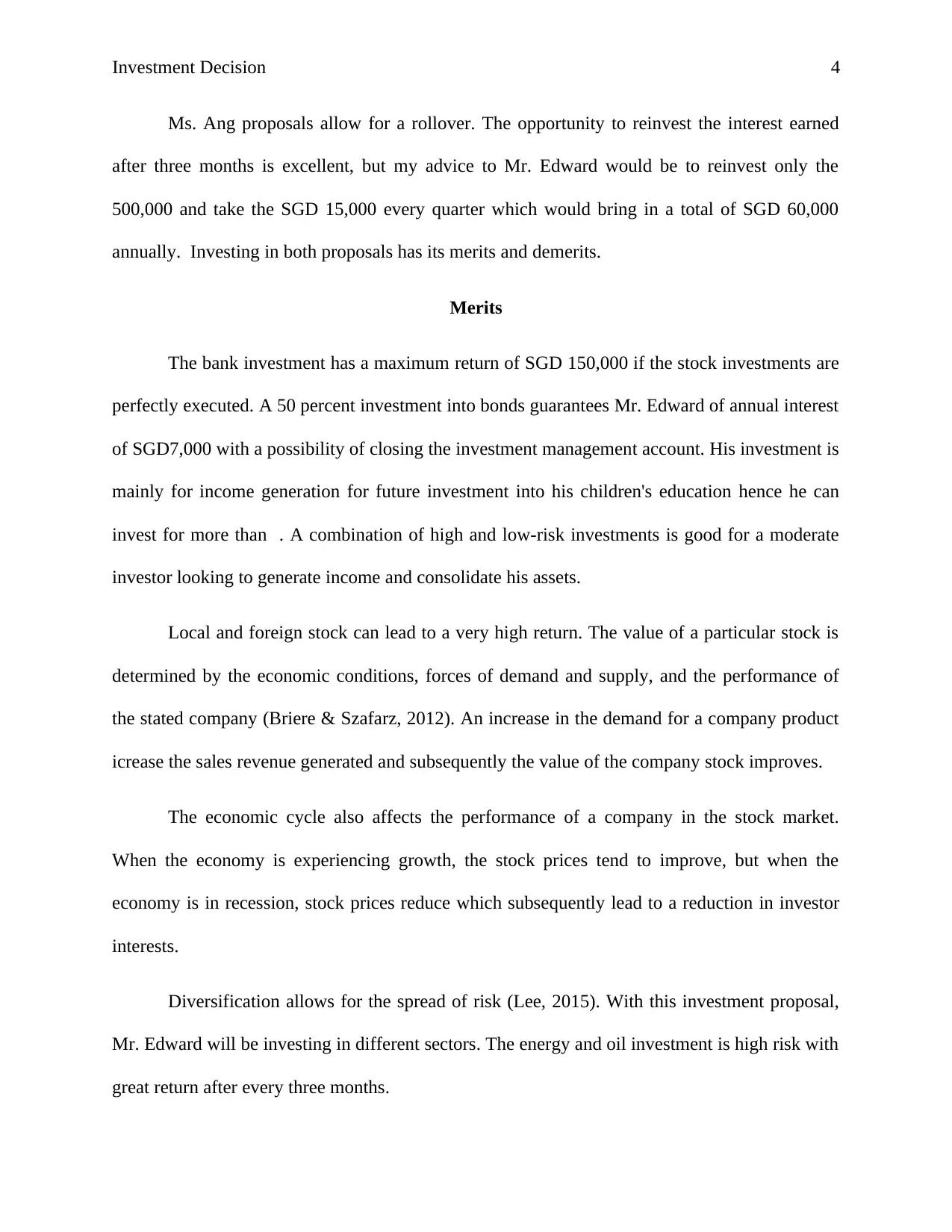
Investment Decision 4
Ms. Ang proposals allow for a rollover. The opportunity to reinvest the interest earned
after three months is excellent, but my advice to Mr. Edward would be to reinvest only the
500,000 and take the SGD 15,000 every quarter which would bring in a total of SGD 60,000
annually. Investing in both proposals has its merits and demerits.
Merits
The bank investment has a maximum return of SGD 150,000 if the stock investments are
perfectly executed. A 50 percent investment into bonds guarantees Mr. Edward of annual interest
of SGD7,000 with a possibility of closing the investment management account. His investment is
mainly for income generation for future investment into his children's education hence he can
invest for more than . A combination of high and low-risk investments is good for a moderate
investor looking to generate income and consolidate his assets.
Local and foreign stock can lead to a very high return. The value of a particular stock is
determined by the economic conditions, forces of demand and supply, and the performance of
the stated company (Briere & Szafarz, 2012). An increase in the demand for a company product
icrease the sales revenue generated and subsequently the value of the company stock improves.
The economic cycle also affects the performance of a company in the stock market.
When the economy is experiencing growth, the stock prices tend to improve, but when the
economy is in recession, stock prices reduce which subsequently lead to a reduction in investor
interests.
Diversification allows for the spread of risk (Lee, 2015). With this investment proposal,
Mr. Edward will be investing in different sectors. The energy and oil investment is high risk with
great return after every three months.
Ms. Ang proposals allow for a rollover. The opportunity to reinvest the interest earned
after three months is excellent, but my advice to Mr. Edward would be to reinvest only the
500,000 and take the SGD 15,000 every quarter which would bring in a total of SGD 60,000
annually. Investing in both proposals has its merits and demerits.
Merits
The bank investment has a maximum return of SGD 150,000 if the stock investments are
perfectly executed. A 50 percent investment into bonds guarantees Mr. Edward of annual interest
of SGD7,000 with a possibility of closing the investment management account. His investment is
mainly for income generation for future investment into his children's education hence he can
invest for more than . A combination of high and low-risk investments is good for a moderate
investor looking to generate income and consolidate his assets.
Local and foreign stock can lead to a very high return. The value of a particular stock is
determined by the economic conditions, forces of demand and supply, and the performance of
the stated company (Briere & Szafarz, 2012). An increase in the demand for a company product
icrease the sales revenue generated and subsequently the value of the company stock improves.
The economic cycle also affects the performance of a company in the stock market.
When the economy is experiencing growth, the stock prices tend to improve, but when the
economy is in recession, stock prices reduce which subsequently lead to a reduction in investor
interests.
Diversification allows for the spread of risk (Lee, 2015). With this investment proposal,
Mr. Edward will be investing in different sectors. The energy and oil investment is high risk with
great return after every three months.
Secure Best Marks with AI Grader
Need help grading? Try our AI Grader for instant feedback on your assignments.
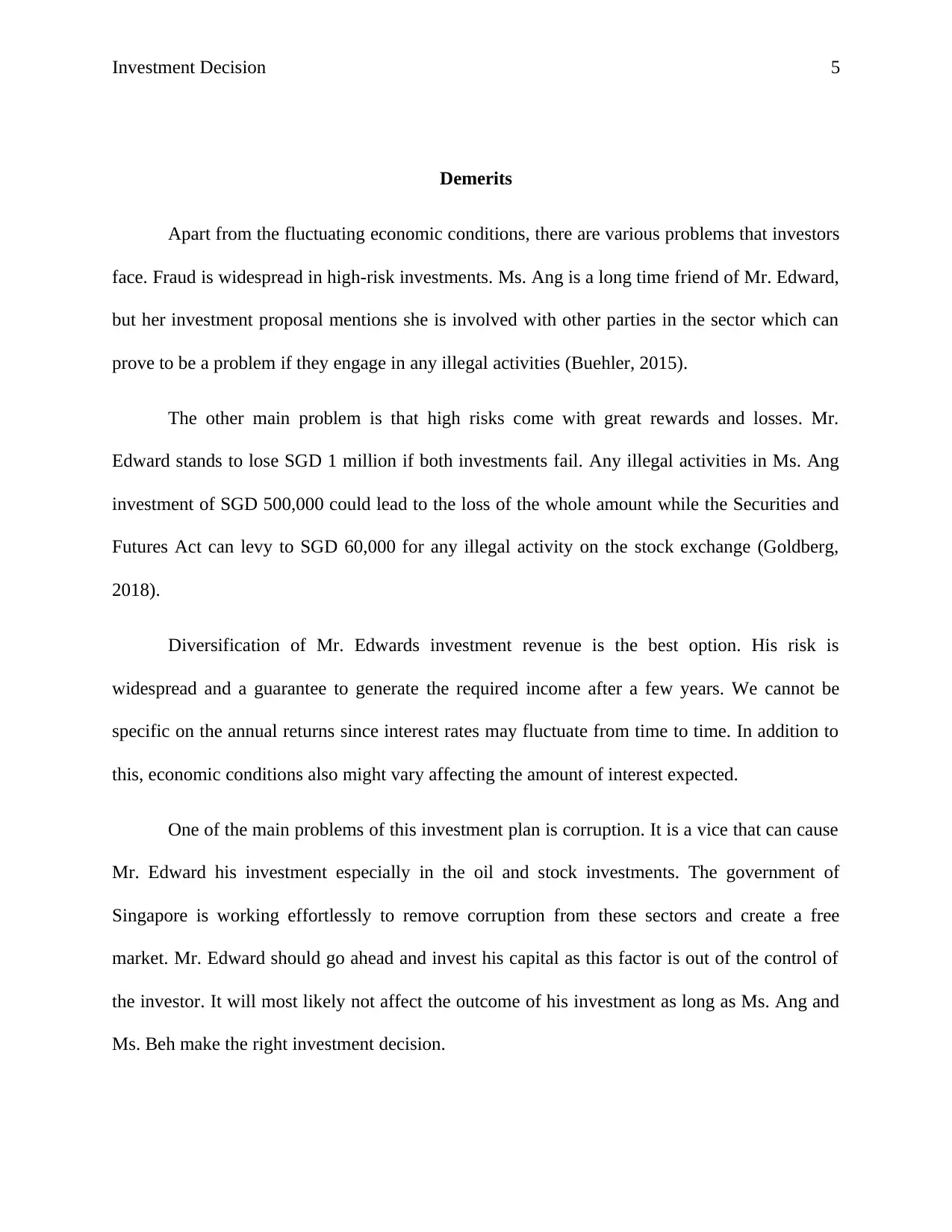
Investment Decision 5
Demerits
Apart from the fluctuating economic conditions, there are various problems that investors
face. Fraud is widespread in high-risk investments. Ms. Ang is a long time friend of Mr. Edward,
but her investment proposal mentions she is involved with other parties in the sector which can
prove to be a problem if they engage in any illegal activities (Buehler, 2015).
The other main problem is that high risks come with great rewards and losses. Mr.
Edward stands to lose SGD 1 million if both investments fail. Any illegal activities in Ms. Ang
investment of SGD 500,000 could lead to the loss of the whole amount while the Securities and
Futures Act can levy to SGD 60,000 for any illegal activity on the stock exchange (Goldberg,
2018).
Diversification of Mr. Edwards investment revenue is the best option. His risk is
widespread and a guarantee to generate the required income after a few years. We cannot be
specific on the annual returns since interest rates may fluctuate from time to time. In addition to
this, economic conditions also might vary affecting the amount of interest expected.
One of the main problems of this investment plan is corruption. It is a vice that can cause
Mr. Edward his investment especially in the oil and stock investments. The government of
Singapore is working effortlessly to remove corruption from these sectors and create a free
market. Mr. Edward should go ahead and invest his capital as this factor is out of the control of
the investor. It will most likely not affect the outcome of his investment as long as Ms. Ang and
Ms. Beh make the right investment decision.
Demerits
Apart from the fluctuating economic conditions, there are various problems that investors
face. Fraud is widespread in high-risk investments. Ms. Ang is a long time friend of Mr. Edward,
but her investment proposal mentions she is involved with other parties in the sector which can
prove to be a problem if they engage in any illegal activities (Buehler, 2015).
The other main problem is that high risks come with great rewards and losses. Mr.
Edward stands to lose SGD 1 million if both investments fail. Any illegal activities in Ms. Ang
investment of SGD 500,000 could lead to the loss of the whole amount while the Securities and
Futures Act can levy to SGD 60,000 for any illegal activity on the stock exchange (Goldberg,
2018).
Diversification of Mr. Edwards investment revenue is the best option. His risk is
widespread and a guarantee to generate the required income after a few years. We cannot be
specific on the annual returns since interest rates may fluctuate from time to time. In addition to
this, economic conditions also might vary affecting the amount of interest expected.
One of the main problems of this investment plan is corruption. It is a vice that can cause
Mr. Edward his investment especially in the oil and stock investments. The government of
Singapore is working effortlessly to remove corruption from these sectors and create a free
market. Mr. Edward should go ahead and invest his capital as this factor is out of the control of
the investor. It will most likely not affect the outcome of his investment as long as Ms. Ang and
Ms. Beh make the right investment decision.
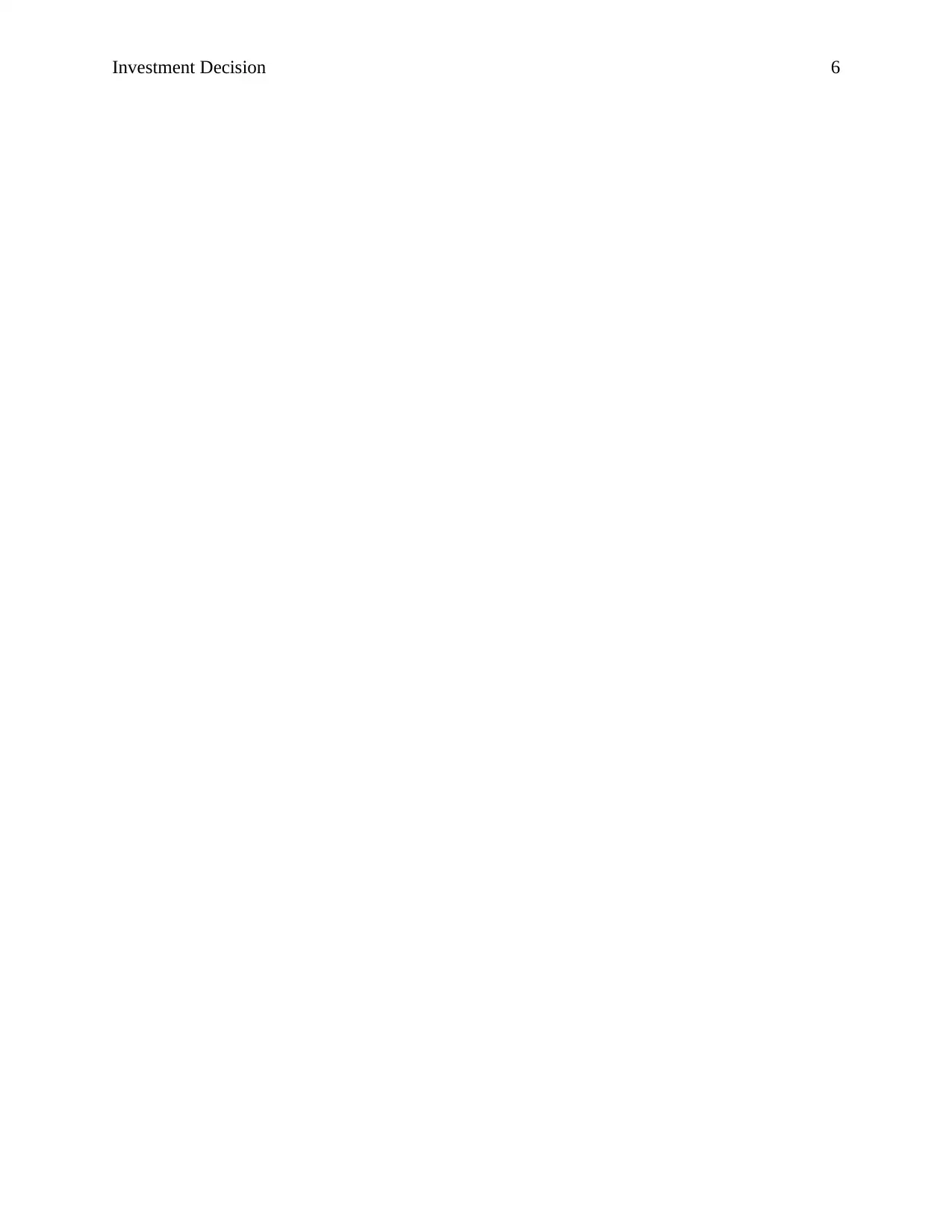
Investment Decision 6
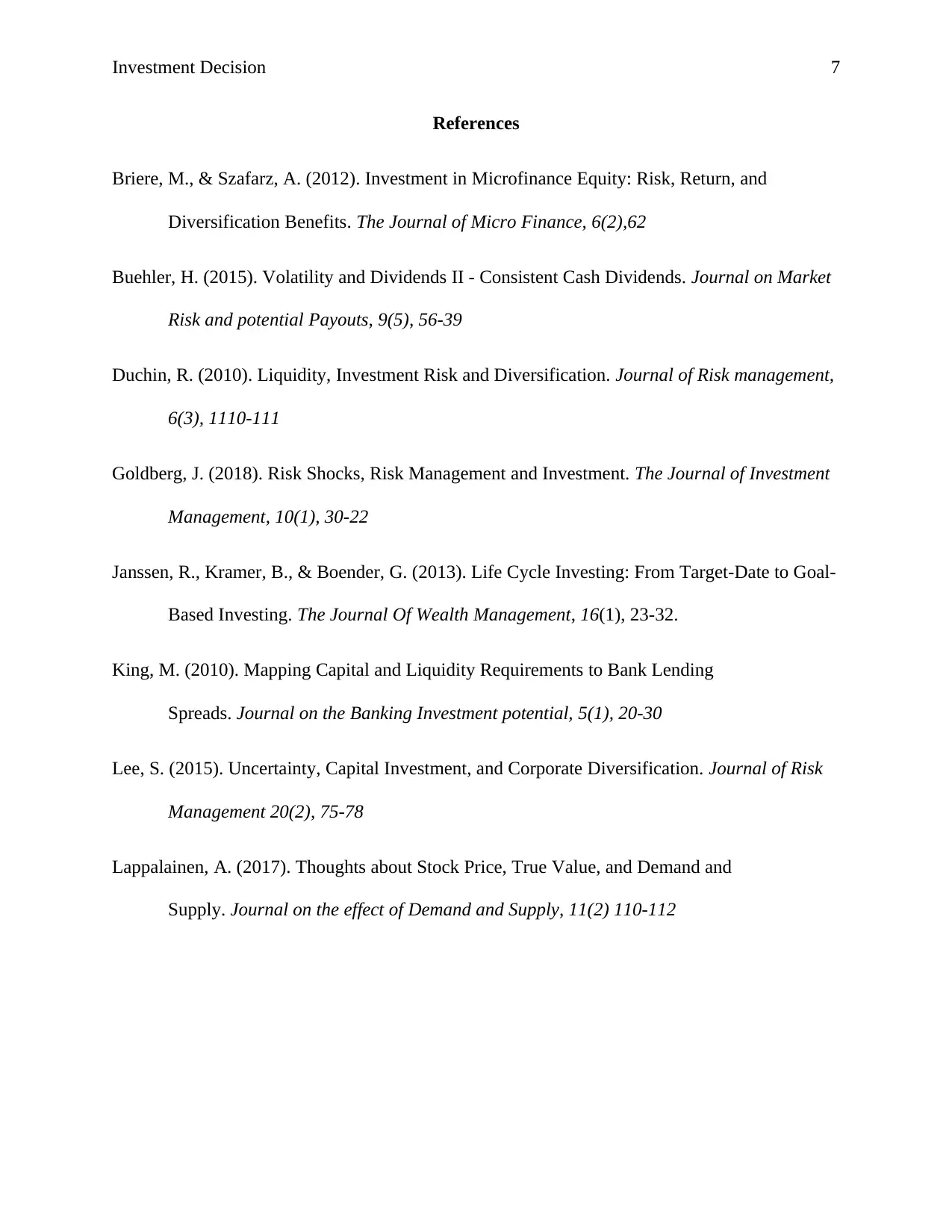
Investment Decision 7
References
Briere, M., & Szafarz, A. (2012). Investment in Microfinance Equity: Risk, Return, and
Diversification Benefits. The Journal of Micro Finance, 6(2),62
Buehler, H. (2015). Volatility and Dividends II - Consistent Cash Dividends. Journal on Market
Risk and potential Payouts, 9(5), 56-39
Duchin, R. (2010). Liquidity, Investment Risk and Diversification. Journal of Risk management,
6(3), 1110-111
Goldberg, J. (2018). Risk Shocks, Risk Management and Investment. The Journal of Investment
Management, 10(1), 30-22
Janssen, R., Kramer, B., & Boender, G. (2013). Life Cycle Investing: From Target-Date to Goal-
Based Investing. The Journal Of Wealth Management, 16(1), 23-32.
King, M. (2010). Mapping Capital and Liquidity Requirements to Bank Lending
Spreads. Journal on the Banking Investment potential, 5(1), 20-30
Lee, S. (2015). Uncertainty, Capital Investment, and Corporate Diversification. Journal of Risk
Management 20(2), 75-78
Lappalainen, A. (2017). Thoughts about Stock Price, True Value, and Demand and
Supply. Journal on the effect of Demand and Supply, 11(2) 110-112
References
Briere, M., & Szafarz, A. (2012). Investment in Microfinance Equity: Risk, Return, and
Diversification Benefits. The Journal of Micro Finance, 6(2),62
Buehler, H. (2015). Volatility and Dividends II - Consistent Cash Dividends. Journal on Market
Risk and potential Payouts, 9(5), 56-39
Duchin, R. (2010). Liquidity, Investment Risk and Diversification. Journal of Risk management,
6(3), 1110-111
Goldberg, J. (2018). Risk Shocks, Risk Management and Investment. The Journal of Investment
Management, 10(1), 30-22
Janssen, R., Kramer, B., & Boender, G. (2013). Life Cycle Investing: From Target-Date to Goal-
Based Investing. The Journal Of Wealth Management, 16(1), 23-32.
King, M. (2010). Mapping Capital and Liquidity Requirements to Bank Lending
Spreads. Journal on the Banking Investment potential, 5(1), 20-30
Lee, S. (2015). Uncertainty, Capital Investment, and Corporate Diversification. Journal of Risk
Management 20(2), 75-78
Lappalainen, A. (2017). Thoughts about Stock Price, True Value, and Demand and
Supply. Journal on the effect of Demand and Supply, 11(2) 110-112
1 out of 7
Your All-in-One AI-Powered Toolkit for Academic Success.
+13062052269
info@desklib.com
Available 24*7 on WhatsApp / Email
![[object Object]](/_next/static/media/star-bottom.7253800d.svg)
Unlock your academic potential
© 2024 | Zucol Services PVT LTD | All rights reserved.


